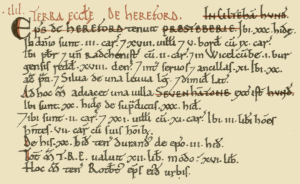There has been a village in Prestbury since before the Norman Conquest; the Domesday survey records a settlement of about 25 families and a priest. The Parish boundaries established in Anglo-Saxon times remain almost unchanged to our own day. They define a long thin area stretching from the hill top East of the village almost to the main line railway in the West.
(Left: Domesday Book images kindly made available by Professor J.J.N. Palmer and George Slater domesdaymap.co.uk. Images may be reused under a Creative Commons BY-SA licence)
The presence of Cheltenham, no more than one and a half miles southwest, has had considerable influence on Prestbury for both good and ill. Competition from the bigger towns must have been partly responsible for the decline of Prestbury’s medieval market, established in 1249. By the 15th century it was in serious decline and a subsiquent attempt to revive it fared no better. On the other hand, the growing prosperity of Cheltenham offered increasing opportunities for employment and trade for villagers. In the 19th century Prestbury growers and farmers helped to supply the tables of Cheltenham, and Prestbury housed many of the building workers for the expanding spa town.
Prestbury cannot claim a starring role in national events, but it was touched and changed by all the great movements of English history. The way they played out on the small stage of a village makes their human impact very real. The decline of feudalism and the rise of a middle class, the Reformation, the Civil War, increasing professionalism in agriculture, all have their reflection in the story of Prestbury. Today, the built-up area of Cheltenham extends to and includes Prestbury, but a strong village identity persists. There are flourishing schools, 2 churches, shops, 4 pubs, a hall and a library. Many residents have deep family roots here, and one of the aims of Prestbury Local History Society is the collection and preservation of their memories. History continues to the present.


